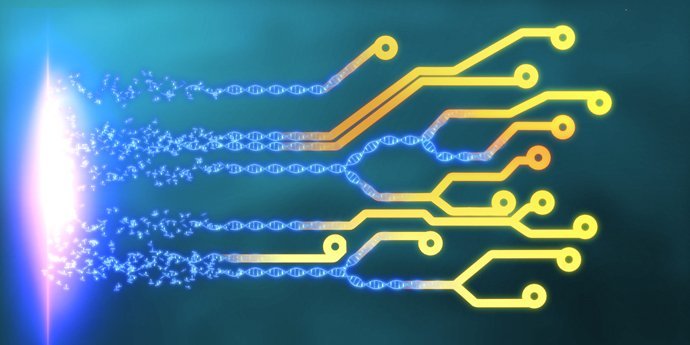|
Author Ian MacArthur
Editor Josephine McGowan Electronic circuits are the backbone of modern civilization. The logical processes they perform underlie the function of all computational devices, ranging in complexity from the simplest calculators up to the most advanced supercomputers. However, the execution of logical tasks need not be confined to inorganic circuitry. Extensive research has been devoted to the development of synthetic biological circuits, amalgamations of cells that are able to interact with their surrounding environment and respond in precise ways. The logical functions of basic electronic circuits occur through responding to inputs with specific outputs. A group of cells mimics this process on a genetic level. Molecules in the environment around a cell may bind to plasma membrane receptors and signal the cell to manufacture a specific gene product. Such pathways are an integral part of how cells naturally regulate their metabolism in response to the external environment. For example, lactose induces the production of the enzyme b-galactosidase (b-gal) in E. coli, which then cleaves the sugar into glucose and galactose. In the absence of lactose, the cell does not manufacture b-galactosidase because a repressor protein is bound to the operator of the b-gal gene. An operator is a regulatory region of DNA whose state determines whether a gene will be expressed. Lactose binding to the repressor protein causes it to dissociate from the operator, allowing gene expression to be carried out by enzymes binding the promoter, another regulatory DNA region that initiates gene transcription. Evolution has tailored genetic circuits to be highly precise. All of the genetic machinery of a cell is suited for the natural inputs it may receive. The challenge in constructing synthetic biological circuits, then, is to use this existing machinery to enable the cell to respond in new and precise ways. Diabetes, for instance, has been imagined as a potential therapeutic application of biological circuits. An artificial probe composed of glucose-sensitive cells might circulate in the blood of a diabetic and monitor glucose levels. At a specific threshold, the sensor cell would begin to produce and release insulin, or signal a cell downstream in the circuit to do so. Glucose, however, is a common biological signal that may induce a cascade of events when present in a cell. If the effect of glucose on the circuit is not precisely controlled, it may affect metabolism or gene expression in undesirable ways. To address this problem, researchers may have to extensively remodel the genome of circuit cells by inserting repressible and inducible gene promoters to ensure the cells respond to stimuli as intended. Another challenge in designing synthetic biological circuits is accounting for the complexity of biological conditions and environments. A circuit intended to detect toxic conditions in the body may have to respond to several molecules in combination that, when present independently, are not indicative of pathological conditions. In 2012, MIT scientists announced the development of a synthetic biological circuit capable of detecting four molecular inputs. Further expansion and refinement of input sensitivity will be necessary if circuits are to be widely applied for therapeutic purposes. Cancer is likely the most problematic disease for synthetic circuits to address. The close resemblance of cancer cells to healthy cells means that a circuit designed to detect cancer would have to be capable of sensing subtle molecular differences between these cell types. Moreover, if the circuit was engineered to release a cytotoxic agent or initiate an immune response against cancer, the delivery of the output drug or signal must be designed to avoid healthy tissues. Presently, synthetic biological circuits are several years away from commercial and medical applications. However, the specificity in detection and response they can provide poses them as an intriguing solution to some of our most difficult biological and medical problems. Just as in the case of electronic circuits, the ceiling for biological circuit sophistication and utility promises to be high.
0 Comments
Leave a Reply. |
Categories
All
Archives
April 2024
|

